Holiday 2010 System Builder's Guide
by AnandTech Staff, edited by Jarred Walton on November 19, 2010 2:00 AM EST- Posted in
- Guides
- Systems
- Holiday 2010
| Brian's Intel Dream PC | ||
| Hardware | Component | Price |
| Processor |
2x Intel Xeon X5660 Westmere 32nm (Hex-core + HTT, 2.8 to 3.2 GHz, 12MB L3, 95W) |
2x $1225 |
| CPU HSF | 2x Xigmatek Dark Knight-S1283V | 2x $45 |
| Motherboard |
EVGA Classified SR-2 (Intel 5520, ICH10R, 270-WS-W555-A2) |
$590 |
| GPU | 2x EVGA SuperClocked GTX 580 | 2x $530 |
| Hard Drives | 4x Western Digital 1.5TB (WD1501FASS) | 4x $120 |
| OS Drive (SSD) | OCZ RevoDrive X2 240GB PCI-E 4x SSD | $680 |
| Memory | 2x Patriot 12GB (3x4GB) DDR3 1333 | 2x $360 |
| Power Supply | Antec TPQ-1200 80 Plus Silver | $250 |
| Case | Lian Li PC-V2120X ATX Full Tower | $500 |
| Optical Drive | LG 10x Blu-Ray Burner w/Lightscribe | $100 |
| Keyboard | Das Keyboard Professional Model S Silent | $135 |
| Alt Keyboard | Logitech G510 Keyboard | $100 |
| Mouse | Razer Mamba 5600 DPI Wired/Wireless | $130 |
| Monitor | Dell U3011 30" 2560x1600 IPS | $1350 |
| Sound Card | Creative 7.1 24-bit PCI-E X-Fi Titanium | $75 |
| Total System Price | $8610 | |
When I heard that the whole AnandTech staff was going to get to put together a rig of their choice, I instantly gravitated to the super high end. Heck, there's no reason you can't at least ask for the absolute best, even if you know it's out of your price range. For others, maybe you really do want to go sky high and push the limits of what's possible with desktop parts without getting too exotic. Either way, this dream machine build isn't for the faint of heart.
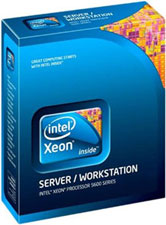
I've configured and built a number of dual processor Xeon 56xx series workstations in the past, yet each time destined for a fairly mundane existence doing computational modeling or some other serious business. Each time I'm finished, there's a brief but overwhelming temptation to install Crysis, Metro 2033—heck, something!—with all the eye candy on max with a 2560x1600 display. Each time, I shake that thought away right after finishing burn-in testing as I pop in the latest version of whatever *nix flavor is appropriate. I kid myself that maybe eventually I'll be able to build something like this without having to justify every bit of it as being vitally critical for modeling complicated scientific something or other. Anyway, if you've got nearly limitless piles of sweet cash lying around, this is the rig for you.
Starting out is really the motherboard. Initially, I wanted to go with a server-class motherboard, the SupermicroMBD-X8DTi, having worked with it and similar workstation boards in the past. If you want a dual CPU motherboard, the options basically dictate either a similar class of "server" motherboard like theMBD-X8DTi from Supermicro, something comparable from Tyan, or the only choice in the more conventional desktop class of products, the EVGA Classified SR-2. TheMBD-X8DTi and SR-2 are actually quite similar; both are built around the Intel 5520 and ICH10R chipsets, both are happy with an unreasonable number of triple 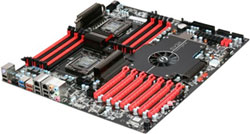 channel ECC or non-ECC DDR3-1333 memory, and both actually present similar PCI-E lane configurations. The Supermicro comes with onboard graphics, but we'd obviously recommend disabling that in the BIOS and forgetting about it. The Supermicro board costs $430, whereas the Classified SR-2 costs a slightly mind-bending $590. The difference between the two is ultimately whether you want SLI licensing so you can stick in some some multi-GPU goodness from NVIDIA. Remember that NVIDIA still requires either a BIOS key or NVIDIA bridge chip for SLI to work, both of which the cheaper Supermicro board lacks. AMD CrossFire remains feasible on both, but that difference, along with the more enthusiast-oriented features like overclocking support, ultimately led me to settle on the SR-2, despite its nose-bleed-inducing price tag.
channel ECC or non-ECC DDR3-1333 memory, and both actually present similar PCI-E lane configurations. The Supermicro comes with onboard graphics, but we'd obviously recommend disabling that in the BIOS and forgetting about it. The Supermicro board costs $430, whereas the Classified SR-2 costs a slightly mind-bending $590. The difference between the two is ultimately whether you want SLI licensing so you can stick in some some multi-GPU goodness from NVIDIA. Remember that NVIDIA still requires either a BIOS key or NVIDIA bridge chip for SLI to work, both of which the cheaper Supermicro board lacks. AMD CrossFire remains feasible on both, but that difference, along with the more enthusiast-oriented features like overclocking support, ultimately led me to settle on the SR-2, despite its nose-bleed-inducing price tag.
Of course, now that we've incurred such a large price premium to get a two-socket motherboard, we should stick in at least a couple hex-core CPUs, right? Two 6-core CPUs with Hyper-Threading gives a whopping 24 threads of power. For that, there's Intel Westmere—the SR-2 andMBX-X8DTi both support Xeon 5500 and 5600 series. At the most extreme, there's the 3.33GHz Xeon 5680, which runs $1725, but anyone can sort by price and see what's the most expensive, and we're still at least somewhat interested in performance per buck (or are we?) The Xeon 5680 can Turbo from 3.33GHz to 3.6GHz. Subjectively, the Xeon X5660 seems to be a better tradeoff between price and stock clock speed at 2.8GHz, plus you get a larger turbo boost up to 3.2GHz. Either way, the two CPUs will set you back a big chunk of change. As one reader pointed out, you also need a heatsink for Xeon, as it doesn't ship with one, so we grabbed a couple of Xigmatek Dark-Knight coolers.
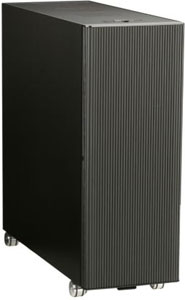
In the traditional workstation configuration, I usually opt for a Cooler Master Cosmos or Cosmos S, and when I think about what's really ultimate in the case market these days, my mind immediately settles on either the iconic Thermaltake Level 10 or the ABS Canyon 695. TheMBD-X8DTi and other workstation boards are E-ATX, which would fit in all the aforementioned cases but the Level 10. Unfortunately, the SR-2 is enormous and necessitated EVGA to define their own motherboard form factor entirely—HPTX—which is a mind-numbing 13.6" x 15". The result is that our case recommendation is limited unless you're willing to go custom or break out the Dremel. Luckily, there's a line of HPTX cases by Lian Li that are attractive and fit the SR-2 just fine. If you're opposed to finding a motherboard tray properly machined for HPTX or loath to do modifications yourself, the Lian Li PC-V2120X is what you should go for.
Moving along we come to the GPUs; I talked with Ryan on this to get his input, and ultimately we both agreed on 2xSLI GTX 580s. EVGA is (at time of this writing) offering the Superclocked version at 797MHz core/1594MHz shader clocks for prices on par with the competition's regularly clocked GTX 580s. The choice is simple at that point: go for the factory overclocked EVGA while it's still feasible.
Storage on a dream build would be incomplete without an SSD for the OS. Thankfully, the RevoDrive X2 is indeed bootable and thus makes an ideal drive for the OS and critical system apps. On every system I've built in recent memory, I've gone with an SSD + RAID array of slow but capacious storage; I think the same is best here. Get four or five 1.5TB or higher HDDs of whatever brand makes you feel warmest inside, toss them in a RAID5 set, and enjoy a crap-ton of storage that's fully redundant. I suppose if you're really feeling ultimate, you could get a RAID card instead of using the ICH10R's software fakeRAID, but it probably isn't critical unless you want to eek out everything you can from those mechanical drives.
My dream PC would be incomplete without at least 12GB of RAM—it's just that simple. I think it's safe to say that 6GB is pretty standard for midrange X58 gaming builds, with 8GB and 12GB starting to become the norm at the fringes. To stay safely ahead, you've got to move to 24GB, which is actually surprisingly common for workstations processing huge datasets that need to exist entirely in RAM. Of course, it's more than likely that no game will ever make use of the 24GB, but we're building the ultimate system here, right? The objective is to play Crysis within Crysis if we could. I settled on two sets of matched Patriot 12GB (3x4GB) kits, as all the 24GB (3x8GB) kits I could find were either sold out or lacked heat spreaders. You should still get triple-channel performance on either the SupermicroMBD-X8DTi or EVGA SR-2 with six populated memory slots, but it definitely makes me a little uneasy populating so many if you don't have lots of airflow.
For the power supply, we're big fans of the Antec TPQ-1200 Silver, which packs a half and half modular/fixed set of cables. It's a combination that provides the best of both worlds for not blocking airflow with unused power cables, and fixed cables for being absolutely certain connectors aren't a concern. The TPQ-1200 is (as the name implies) 1200W, which should be adequate for the SR-2, two Xeons, and two GTX 580s, plus all those mechanical drives.
I'm a fan of LG's 10x Blu-ray burner with LightScribe support, purely because it's SATA, well received, and I've built a number of systems with it in the past. You get DVD+/-R support at 16x, and CDR support at 48x, which is pretty standard. I'm a sucker for LightScribe support just because I always convince myself that the next batch of writeable disks I buy will also be LightScribe; sadly, I've somehow avoided ever doing it. Regardless, the optical drive is quickly becoming marginalized, but for your ultimate build, why not include one? Same thing with the sound card—you don't really need one anymore if onboard audio suffices, but if we're going for the ultimate, you might as well consider it.
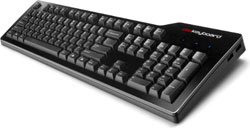
Since we're going all out, we'd be remiss if we didn't include suggestions for the peripherals as well. When I think of the ultimate keyboard, I immediately think of one keyboard—the Das Keyboard. If you haven't heard of it, chances are you've been living under a rock, or been blind sighted by all the flashy gaming-focused keyboards with copious amounts of LED lights but little attention to the mechanics of keydomes. If you want a gaming keyboard, get the Logitech G510—it's awesome and I have one—but if you're serious about typing, consider the Das Keyboard. Das Keyboard is essentially the modern IBM model M equivalent, and is a joy to type on purely because of the serious mechanical and aural feedback. For the mouse, I'm a huge fan of Razer. I worked my way from the Logitech MX1000 (the first laser mouse) through a number of Logitech and Razer mice alike, but keep settling back down on Razer. It's ultimately a matter of personal taste.
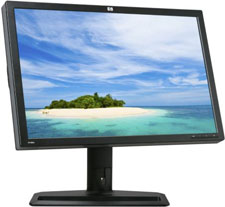
Last but certainly not least is the monitor. The choices here are quite obvious: either buy a 30" Dell U3011 or its archrival, the HP ZR30w. Both are IPS, both look superb, and both round out the dream configuration. Or maybe you need two 30-inchers? I've left out a fan recommendation since the stock fans for these Xeons have (thus far) seemed sufficient, but the usual Zalman 120mm or similar are always an option I'd encourage.
This configuration is again insane, but at the end of it all, I still find myself thoroughly convinced that if I had infinite monies, I'd put it together in a heartbeat—and maybe even splurge for that 3.33GHz Xeon 5680, regardless of the fact that it's overkill even for Crysis. If you had infinite cash or an appetite for the drooling-on-the-carpet insane—and need it right stinkin' now—this is the system I'd recommend, right after I note that Sandy Bridge is right around the corner. If this configuration is financially justifiable to you, by all means, do it! (And send us some benchmarks and pictures!) Alas, for me, it's still little more than a holiday dream.










112 Comments
View All Comments
raghu1111 - Saturday, November 20, 2010 - link
Sorry for the repost. I thought my earlier comment didn't make it.sjfischr - Saturday, November 20, 2010 - link
I think that it's a fantastic setup. To those commenting on the number of drives, let me tell you...as a Ceton owner myself, it's extremely easy to eat up space. I am already eating about 25% of my 4 TB of space thanks to this wonderful card, and I have owned mine for less than four weeks. 1080p HD takes up a good 5.5GB/hr, so let's be certain that many movies approach 12-15 GB apiece. To be sure, I can record up to 4 NFL games at once, and watch them in fast forward (these of course eat up space like crazy). You will need a huge amount of space over time--6TB will be a fine amount of space for now, but think about the fact that as it progresses, the media library will continue to grow.My only disagreement is on the case. Why get a $300 tower when the Thermaltake DH101 provides arguably one of the best examples in the $250 range? The DH101 is full ATX, is quiet enough for most tastes, has 4-3.5" bays, is tool-less, and has a built-in LCD display/remote. The LCD display recently had a firmware update, making it very easy-to-read, and it extremely customizable. With a supplied IR remote, this enables anyone (not just iPhone/Android folks) to point at the device and find what they want. I combine this with a Logitech diNovo Mini (it's much sleeker), and I agree that this combination of case, remote, and keyboard rate the highest on the Spousal Approval Factor.
just4U - Saturday, November 20, 2010 - link
With options out there for memory that is in the cas 6-7 range I am not quite sure I understand why those of you building the more expensive systems are not considering them..It doesn't make sense. Please explain.
just4U - Saturday, November 20, 2010 - link
A prime example comes from this link (the cas 6 lineup at Newegg)http://www.newegg.com/Product/ProductList.aspx?Sub...
For me it's at the point where I don't care if it it goes higher I want those latancies to come down so ... C9 is great for a budget system but higher end?
JarredWalton - Sunday, November 21, 2010 - link
My personal experience with high-end RAM over the years has been less than ideal. Notice how all the CL6 RAM requires 1.6 to 1.65V, and compatibility with motherboards is less certain. A good mobo should work with it, and it would be faster than CL9 or CL8 memory, but it's not going to be such a huge difference that I'm personally ready to recommend spending $30 more on it. Besides, many of the DDR3 kits can do better timing with a bit of added voltage (just like the CL6 kits). If you want better RAM, by all means go for it, but I'm not promising it will always work.iMav - Sunday, November 21, 2010 - link
Another recommendation for Unicomp. Their keyboards ARE the modern-day Model M's. Not Model M-like, they are honest to goodness Model M keyboards.Definitely check out geekhack.org for more information you'd ever care to know about regarding mechanical keyboards.
jonup - Sunday, November 21, 2010 - link
I can't agree more with Anand's mobo/CPU recommendation. I am personally waiting for Sandy for my next build. Meanwhile, I picked up this yesterday: http://www.newegg.com/Product/ComboDealDetails.asp... . For an extra $4 I got P2X4 940 and a similarly/slightly better spec'ed 785G mobo. I think that the extra core and 6MB of cash are worth the for buck. The trade off is that I am stuck with DDR2 but it is not an issue for me since I have 4GB in the system I am putting it in.All in all, stick with Anand's choice of picking up a cheap CPU/mobo and wait till January/February of next year. I would even extend this recommendation to the choice of SSD. With many new and exciting SSDs coming out soon after the holidays and the lower production costs of the 28nm manufacturing we should expect higher performance/capacity and lower prices once the next generations start popping up. Maybe 60GB for $100-130 or 80-90GB for <$150 would be a smarter investment.
ivaxona - Sunday, November 21, 2010 - link
I've already placed the orders, most of the components arrived.Pjenom II X4 955 - bought second hand
Gigabyte 880GM-UD2H
Corsair xms3 2x2GB 1600MHZ
Seagate 500GB and dvd-rw from my old PC
Antec p180 mini
Seasonic M12II 430W
I will buy a 6850 as soon as i have the money, until then the onboard 4250 has to keep me covered. A Corsair force 60 gb on the long run and better cpu cooler. Maybe i'll wait for a new revision of coolermaster Hyper 212 after the new amd socket arrives :)
GullLars - Sunday, November 21, 2010 - link
I have a couple of points i want to make in critique of this so called "dream PC".First off, while the RevoDrive x2 is a great single part that will not be a bottleneck in any normal system, this is not a normal system, and if you clock the CPUs a bit, it can still be a major bottleneck for bandwidth of incompressible data (like media, compressed or encrypted files).
RAID-5 off ICH10R with 4x 1,5TB HDDs isn't dreamy either (4R5).
Since this is a $8K+ "dream system", i feel it warrants a real hardware RAID controller, like the Areca 1880 with a 4GB stick of RAM. This controller supports 6Gbps SATA/SAS and plays nice with SSDs, and comes with 8-24 ports with good support of expanders, should they be needed. You can also hit 2GB/s bandwidth and >100K random IOPS.
I'd suggest 8R6 Hitachi/Seagate Green 2TB drives + 4-8R0 Crucial C300 from the 12 or 16 port versions. The capacity of the SSDs dedicated by the budget, 8R0 of lower capacity taking priority over 4R0 of higher capacity. OFC with an image of the SSD RAID kept on the HDD RAID, and daily backups of userdata kept on the SSDs.
I'd also list water cooling as an alternative, especially since 2x 580 in SLI would benefit from being watercooled.
eBob - Sunday, November 21, 2010 - link
I was wondering if there are any companies that provide remote control hardware for HTPCs other than Soundgraph/iMon. My current HTPC case has this solution pre-installed and it has been a huge headache. Basically, I am unable to turn power on from the remote after turning power off. If I turn off power at the power supply and turn it back on the remote works, but only once. I am running a Linux OS on this box and apparently Soundgraph is unable or unwilling to support such a setup and their customer support is useless.